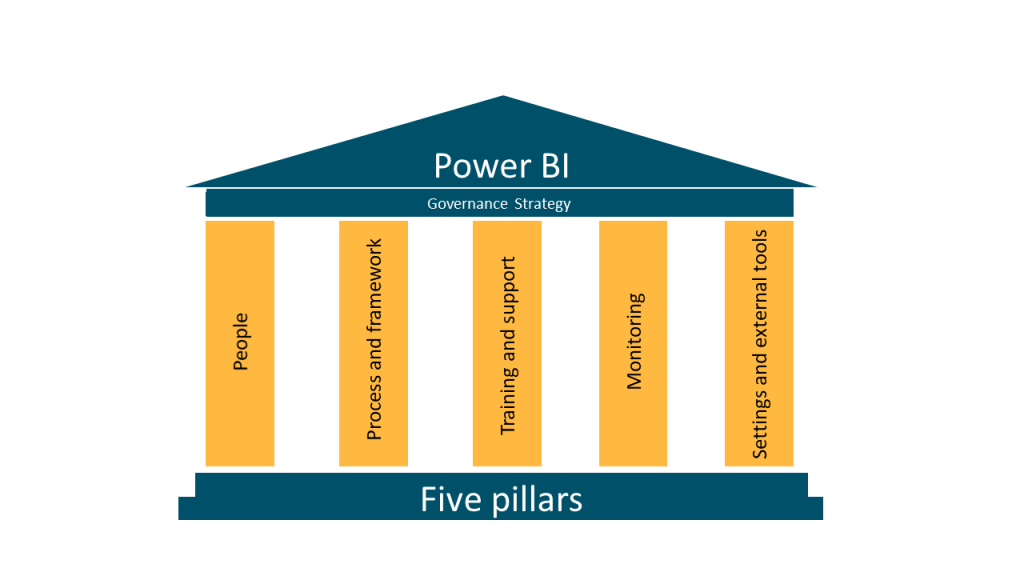This is the first part in a 7 part series on Power BI governance. I will add links to the next parts as I publish them.
Part 1. Introduction to Power BI governance
Governance can mean many things and often different things to different people. In this article series I want talk about my view on Power BI governance and what I think you should be doing when it comes to governing your Power BI environment.
Before I go any further, I just want to mention that Microsoft has some material on Power BI governance that you might be interested in. You can find it here: https://docs.microsoft.com/en-us/power-bi/service-admin-governance
Why governance
Governance is about making sure the right people do the right thing within the defined boundaries of the organization. We need to make sure the BI system (Power BI) does not expose data to the wrong people and that the artifacts are stored, shared, and maintained in the right way. Furthermore, we need to make sure that the users, creators, and administrators know how to use, manage, and secure the artifacts
As Power BI is partly self-service, it is vital that the governance is implemented early and in such a way that it does not impede creators and users unless necessary. Being restrictive in the wrong place can lead to implementation failure and un-governed solution frequently known as Shadow IT. It´s important to tread carefully to avoid that situation but at the same time make sure your organization is compliant and secure
Governance strategy
In my opinion Power BI governance strategy has 5 pillars, People, Processes and framework, Training and support, monitoring and Settings and external tools.

Most of these pillars are non-technical. Only Monitoring and Settings and external tools are technical. This often distracts organizations as many like to think that problems should be solvable with technology. The reality is that technology can only partly help. As with so many other things the main governance issue is people. Having well trained users that know how to use Power BI in the right way is the best way to stay compliant.
Having a good governance strategy and implementing it properly is therefore a huge step in securing compliance.
The 5 pillars cover all of what your governance strategy implementation should cover (in my mind).
The people pillar is about having the right roles in place and actually recognize that people what have those roles need time to perform them. All too often I see that people have unofficial Power BI roles with no time allocation. For example, I see with few of my clients that the Power BI Administrator is the best Power BI person in the company who is expected to do the administration besides their Power BI development. It might work and often does but it should still be recognized that it takes time and it comes with responsibility which requires it to be done properly.
The processes and framework pillar is about having the proper documents in place so users can use Power BI correctly and be compliant. Processes or best practices are document that describe how to use or administer Power BI. Frameworks often describe the method on which you base the process/best practice documents on.
The training and support pillar is about making sure everyone that uses Power BI has gotten the required training. Here you will describe your training plan, decide what type of training each user type should get and how to make sure you reach everyone with your training. It´s also here you might describe how you support your users going forward with things such as internal user groups or subscription to external training library.
The monitoring pillar is about setting up monitoring of Power BI. Usually, it involves extracting data from the Power BI activity log as well as the Power BI REST APIs for information about existing artifacts in your Power BI tenant. Sometimes you might extract data from other parts of Microsoft 365 such as employee data to supplement the activity and inventory data. This part of the governance effort is both about describing your monitoring (documentation) as well as implementing it.
The settings and external tools pillar is about making sure Power BI settings are correctly sat as well as how to use other approved tools to support Power BI. Here you will describe all the settings and their correct value in a document. You will also describe how other tools such as Microsoft 365 sensitivity labels or Tabular Editor should be used with Power BI.
This concludes part 1, introduction to Power BI Governance. Part 2 will cover Power BI Governance strategy